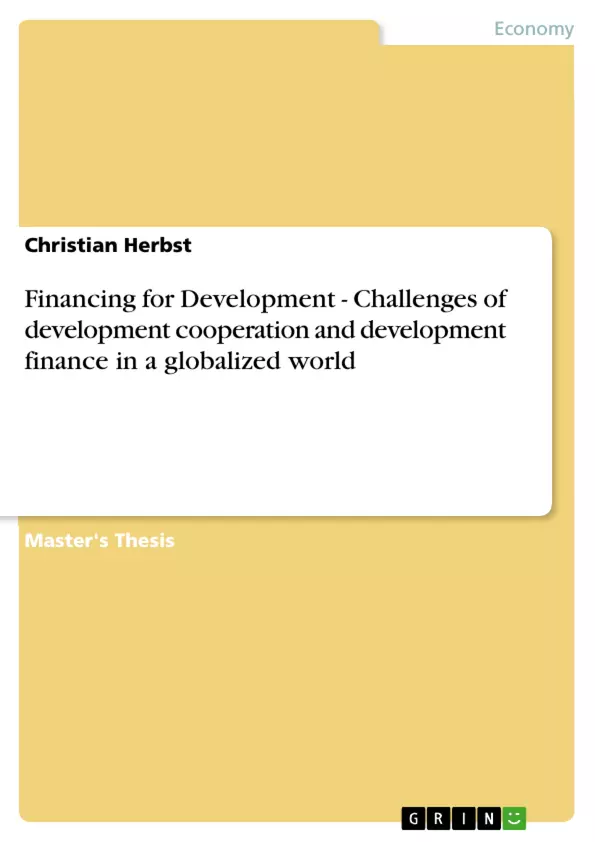Preface
The recent years have been the era of globalization with enormous growth in international trade, financial flows and foreign direct investment (FDI).
Globalization intensifies interdependence between formerly separated nations, however the world seems to be more fragmented, between the rich and the poor, between the powerful and the powerless, and between supporters and opponents of the new global economy.
Current figures reveal the contradiction between those that have managed to benefit from globalization, and those that are considered to be the losers of this period: A girl born in Japan has a 50 percent chance of seeing the chance of seeing the 22nd century, while a newborn in Afghanistan has a 25 percent chance of dying before age 5. The richest five percent of the world’s people have incomes 114 times those of the poorest five1, and the world’s richest one percent of people receive as much income as the poorest 57 percent.2
The developing countries are currently facing two major problems: The first one is income poverty. In order to reduce the share of people living on one Dollar a day, the per capita income has to grow by 3.7 percent annually according to optimistic estimations. However, only 24 developing countries have realized these growth rates in the recent years. On the other hand, more than 127 countries with 34 percent of the world population have not grown at this rate.3 Many countries have suffered negative growth and the share of the poor people has increased, although the public focused increasingly on the poverty problem in the recent years, as it just happened at the “Live Aid Concert.” The second problem is infant mortality. 85 countries are on the track to reduce infant mortality to one third of the 1990 level, but they comprise less than one quarter of the world population. One the other hand, 81 percent of the countries with more than 60 percent of the world population will not be able to achieve this goal until 2015. Every day, more than 30,000 children die of preventable diseases.4 It is dramatic that many countries that will not achieve this goal are among the world’s poorest, i.e. the least – developed countries.
---
1 Source: UNDP, “Human Development Report 2002”, Oxford University Press, Oxford, 2002, Page 13
2 Source: Ibidem, Page 19
3 Source: Ibidem, Page 17
4 Source: Ibidem
Inhaltsverzeichnis (Table of Contents)
- Preface
- Executive summary
- Basic principles
- Definitions
- The term "development"
- Typology of the development countries
- Causes of underdevelopment
- Measuring underdevelopment
- Income and economic power
- Human Development Index
- Human Poverty Index
- Classification of developing countries
- The UN - classification
- The World Bank classification
- The DAC list
- The System of international development co-operation
- Definitions
- Overview
- The United Nations
- Organisations
- The Millennium Goals
- The World Bank Group
- Organizational structure
- The World Bank development strategy
- The World Bank loans
- The International Monetary Fund
- Organizational structure
- The IMF development strategy
- The IMF loans
- The Multilateral Development Banks
- The Kreditanstalt für Wiederaufbau
- The Organization of Economic Co-Operation and Development
- The World Trade Organisation
- Financing of Development
- Overview
- International capital transfer
- Introduction
- The term "capital"
- Reasons for the shortage of capital
- Private equity finance
- Foreign direct Investment
- Foreign portfolio Investment
- Private debt finance
- Bond financing
- Bank loans
- Official aid flows
- Foreign debt
- Causes of debt accumulation
- The dimensions of the developing countries' foreign debt
- Consequences for the developing countries
- International measures / Methods of resolution
- International trade
- The gains from trade: Ghana and South Korea
- International trade theory
- The role of developing countries in global trade
- The Fair Trade initiative
- New sources of development finance
- Currency transaction tax
- Emission trading
- The International Finance Facility
- Microfinance Institutions
- Conclusion
Zielsetzung und Themenschwerpunkte (Objectives and Key Themes)
This master thesis aims to analyze the challenges of development cooperation and development finance in a globalized world. It explores the complex relationship between developed and developing countries and investigates the various approaches and instruments employed to support economic development and reduce poverty.
- The definition and typology of development countries
- The causes and measurement of underdevelopment
- The role of international organizations in development cooperation
- Different forms of international capital transfer and their impact on developing countries
- New sources of development finance and their potential to address global development challenges
Zusammenfassung der Kapitel (Chapter Summaries)
The initial chapters of this thesis lay the groundwork for understanding development cooperation and financing. They define key terms, present a typology of development countries, and explore the causes and measurement of underdevelopment. The thesis also provides an overview of the international development cooperation system, examining the roles of key actors such as the United Nations, the World Bank, and the International Monetary Fund.
Subsequent chapters delve into the financing of development, analyzing different forms of international capital transfer, including foreign direct investment, foreign portfolio investment, and official aid flows. The role of international trade and the challenges posed by foreign debt are also explored.
Finally, the thesis examines new sources of development finance, such as currency transaction taxes, emission trading, and microfinance institutions.
Schlüsselwörter (Keywords)
This master thesis focuses on development cooperation, development finance, globalization, underdevelopment, poverty, international capital transfer, foreign direct investment, foreign portfolio investment, official development assistance, foreign debt, international trade, and new sources of development finance.
- Quote paper
- Christian Herbst (Author), 2005, Financing for Development - Challenges of development cooperation and development finance in a globalized world, Munich, GRIN Verlag, https://www.grin.com/document/51546



